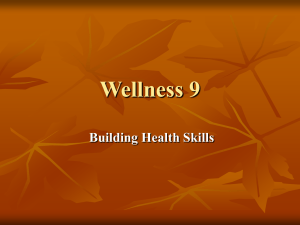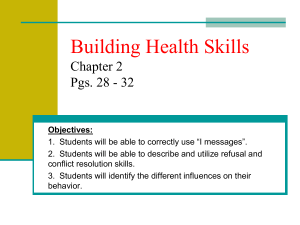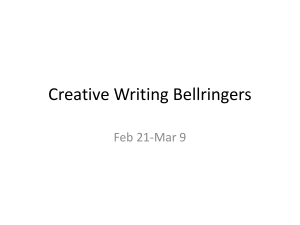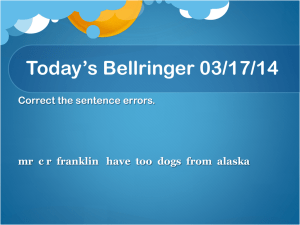Chapter 2 Lifeskills
advertisement
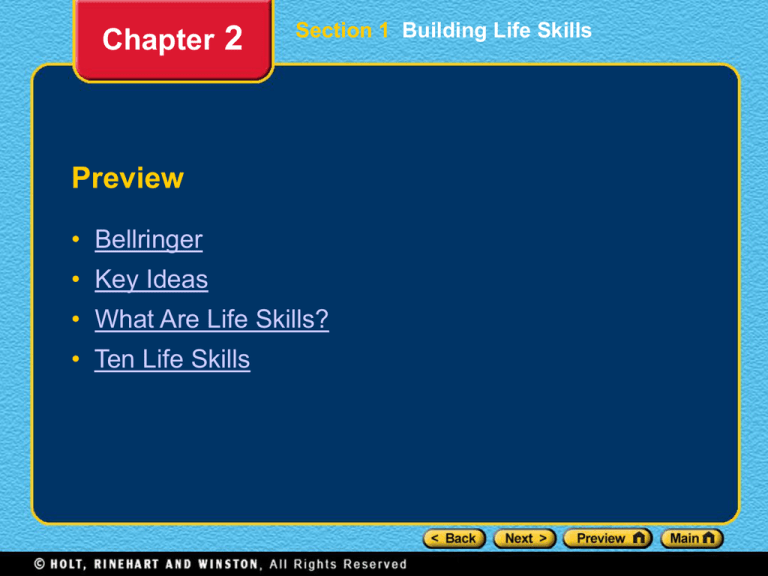
Chapter 2 Section 1 Building Life Skills Preview • Bellringer • Key Ideas • What Are Life Skills? • Ten Life Skills Chapter 2 Section 1 Building Life Skills Bellringer • Make a list of five challenges that you face in your life. What types of life skills do you think would help you face each of these challenges? Chapter 2 Section 1 Building Life Skills Key Ideas • State the importance of practicing life skills for lifelong wellness. • List 10 life skills that you need for a healthy life. • Predict how you can use each of the 10 life skills in your daily life. Chapter 2 Section 1 Building Life Skills What Are Life Skills? • Life skills are tools for building a healthy life. • Like learning to build a house, learning to use life skills takes practice. Chapter 2 Section 1 Building Life Skills Ten Life Skills • • • Assessing Your Health How healthy are you? How are your actions and behaviors affecting your health? Communicating Effectively Listen and speak effectively. Practicing Wellness Practice healthy behaviors for good life-long health. Chapter 2 Section 1 Building Life Skills Ten Life Skills • • • • Coping Deal with troubles or problems in an effective way. Being a Wise Consumer Make good decisions when you buy health products and services. Evaluating Media Messages Recognize the influence of media messages on you and your decisions. Using Community Resources Find and use community resources to help all six components of your health. Chapter 2 Section 1 Building Life Skills Ten Life Skills • • • Making GREAT Decisions Use the making GREAT Decisions model. Using Refusal Skills Say “no” to anything that makes you uncomfortable. Setting Goals Setting goals helps you know where you are going and how you plan to get there. Chapter 2 Section 1 Building Life Skills Chapter 2 Section 2 Making GREAT Decisions Preview • Bellringer • Key Ideas • Importance of Making Decisions • Using the Making GREAT Decisions Model • Making GREAT Decisions Together • Everyone Makes Mistakes Chapter 2 Section 2 Making GREAT Decisions Bellringer • Imagine a friend is pressuring you to sneak out of your house to go to a party. Describe all the possible decisions you could make in this situation. Chapter 2 Section 2 Making GREAT Decisions Key Ideas • Describe the importance of making decisions. • Summarize what you should do if you make a wrong decision. • Apply the Making GREAT Decisions model to make a decision. • Describe a time when you worked with someone else to make a decision. Chapter 2 Section 2 Making GREAT Decisions Importance of Making Decisions • Consequences are the results of your actions and decisions. • Making decisions is important because you are responsible for the consequences. • Impulsive decisions can have negative consequences. • Good decisions often lead to positive outcomes. Chapter 2 Section 2 Making GREAT Decisions Chapter 2 Section 2 Making GREAT Decisions Using the Making GREAT Decisions Model Sina’s Decision • Sina is on her way to school when Marty—a boy she likes—pulls up in his car with his friends. • They are planning to skip school and want her to come. She notices some beer in the back seat. • What should Sina do? Chapter 2 Section 2 Making GREAT Decisions Using the Making GREAT Decisions Model • GIVE Thought to the Problem Sina stops to think before making her decision. • REVIEW Your Choices Sina has at least three choices. • Skip school and go with them • Say “No, thanks.” • Suggest they get together another time Chapter 2 Section 2 Making GREAT Decisions Using the Making GREAT Decisions Model • EVALUATE the Consequences of Each Choice • If she skips school, she could get in trouble, and could be at risk. • If she says “No,” she will not get in trouble, but she will miss a chance to be with Marty. • If she suggests another time, she will not get in trouble, and she could get to be with Marty later—but does she want to? Chapter 2 Section 2 Making GREAT Decisions Using the Making GREAT Decisions Model • ASSESS and Choose the Best Choice Sina realizes she does not want the stress of lying and putting herself at risk. She decides to say, “No, thanks.” • THINK It Over Afterward Sina thinks about her decision later. She is glad she didn’t have to lie or worry about getting in trouble. Chapter 2 Section 2 Making GREAT Decisions Making GREAT Decisions Together • Working with other people can make difficult life decisions easier. • Seek advice from your parents, friends, and teachers. Chapter 2 Section 2 Making GREAT Decisions Everyone Makes Mistakes • If you make a bad decision, use Stop, Think, Go. • STOP and admit you made a wrong decision. • THINK of people you can talk to about the problem. • GO and do your best to correct the situation. Chapter 2 Section 3 Resisting Pressure from Others Preview • Bellringer • Key Ideas • Who Influences You? • Types of Pressure • Refusal Skills • Practicing Refusal Skills Chapter 2 Section 3 Resisting Pressure from Others Bellringer • List a few groups, things, or people that influence your behavior positively and a few negatively. How does each of these influence you? Chapter 2 Section 3 Resisting Pressure from Others Key Ideas • State the people and groups that influence our behavior. • Identify three types of direct pressure. • Identify three types of indirect pressure. • State an example of each of the 12 types of refusal skills. • Apply one of the refusal skills to a pressure in your life. Chapter 2 Section 3 Resisting Pressure from Others Who Influences You? • Positive influences can encourage you to improve yourself or to do good. • Negative influences can pressure you to do something that is unhealthy or dangerous. • Peer pressure is a feeling that you should do something because that is what your friends want. Chapter 2 Section 3 Resisting Pressure from Others Types of Pressure • Direct pressure is the result of someone trying to convince you to do something you normally wouldn’t do. • Indirect pressure results from being swayed to do something because people you look up to are doing it. Chapter 2 Section 3 Resisting Pressure from Others Chapter 2 Section 3 Resisting Pressure from Others Refusal Skills • Refusal skills are strategies to avoid doing things that you feel pressured to do. Chapter 2 Section 3 Resisting Pressure from Others Chapter 2 Section 3 Resisting Pressure from Others Practicing Refusal Skills • It helps to practice refusal skills so you will be ready for real-life pressure situations. • When you say no, always respect others and don’t put anyone down. • If someone keeps pressuring you, then you may have to leave the situation. Chapter 2 Section 4 Setting Healthy Goals Preview • Bellringer • Key Ideas • Kinds of Goals • Six Suggestions for Setting Goals • Make an Action Plan Chapter 2 Section 4 Setting Healthy Goals Bellringer • Identify three goals that you hope to accomplish within the next month and three goals that you hope to accomplish within the next 10 years. Chapter 2 Section 4 Setting Healthy Goals Key Ideas • Differentiate between short-term goals and longterm goals. • Describe six suggestions for setting goals. • Develop an action plan to achieve a personal goal. Chapter 2 Section 4 Setting Healthy Goals Kinds of Goals • A goal is something you work toward and hope to achieve. • Short-term goals can be achieved in days or weeks. • Long-term goals may take months or years to achieve. Chapter 2 Section 4 Setting Healthy Goals Six Suggestions for Setting Goals 1. Safe Goals should not be harmful to you or others. 2. Satisfying You should feel good about yourself when you reach your goals. 3. Sensible Set realistic goals that you can really hope to achieve. Chapter 2 Section 4 Setting Healthy Goals Six Suggestions for Setting Goals 4. Similar Set goals that work well together and do not contradict one another. 5. Specific The steps to achieve your goals should be clear. 6. Supported Your goals should be supported by your parents or other responsible adults. Chapter 2 Section 4 Setting Healthy Goals Make an Action Plan • An action plan is a set of directions that help you reach a goal. • List the rewards you will have when you reach your goal. • Know which influences can hurt you and which influences can help you as you work toward your goal. • Track your progress regularly. Chapter 2 Brain Food Video Quiz Click below to watch the Brain Food Video Quiz that accompanies this chapter. Brain Food Video Quiz



